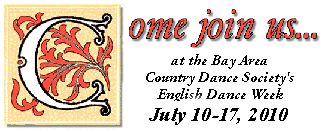|
CLASS DESCRIPTIONS
Why “Hole in the Wall” isn’t a Minuet: Using Baroque Steps in English Country Dances
We know that Baroque dance steps were used in English country dance in the late 17th and early 18th centuries, but very little specific information survives. In this class we will learn common Baroque dance steps such as minuet, bourrée, rigaudon, chassé, gavotte, use them in English country dances and discover why the minuet step is not appropriate for hornpipes (dances in 3/2 meter). The class will focus on dancing more than talking.
Reconstructing Kynaston
An in-depth look at some of Andrew’s Kynaston reconstructions in their original form, and consideration of the questions posed in interpreting and adapting them for modern performance.
ECD: Farnicle Huggy
A selection of dances from Twenty Four New Country Dances Compos’d by a Person of Quality, 1718, and from others of the annual sets of New Country Dances published by John Walsh in the early 18th century.
ECD: Good to Great
Through a series of fun dances to terrific tunes, we’ll look at the skills involved in English dancing — moving, giving weight, fitting figures to phrases, etc. For newer dancers, this will provide a solid foundation and may fill gaps left by picking things up on the fly. For experienced dancers, this material is the key to progressing from someone who dances well to someone who inspires a smile in your partner and brings joy to the band.
Longsword
The original Helmsley longsword dance, as notated by Cecil Sharp, was used as material for a series of sword workshops at the Sidmouth Festival in 1979. The resulting dance was further tinkered with by Spen Valley Longsword, and then their version was further tinkered with by Kalia. This 6-person dance incorporates moves characteristic of traditional longsword dances as well as a few new twists. It’s fun to learn and watch, easy enough for beginners but with enough challenges to keep experienced dancers on their toes.
ECD: Twenty four Old English Country Dances for the Year 2010
A selection of 17th and 18th century dances from a variety of sources will make up this anachronistic annual set.
Callers Workshop
“Communication before choreography, dancers before dances.” This is open to all levels, and we particularly encourage experienced callers who want to keep to growing. We’ll have sessions on theory (managing the dancers’ mental load, basic musical concepts, stage fright, etc.) and also practice calling.
ECD for All: a Potpourri
This session will explore the breadth of the English Country Dance literature: centuries, formations, energy levels, social classes, rhythms and steps. It is open to all experience levels. Musicians are strongly encouraged to attend.
Exploring ECD 18th C. Continental Sources
Longways English country dances were introduced to the French court in 1684 (and may well have been danced there prior to that date.) By the first decades of the 18th century English-style dances had spread throughout Western Europe, as evidenced by the numerous manuscripts and publications that have survived. We will look at sources from France, Belgium, Germany, Italy, and Spain, comparing each country’s notation system and approach to the English model. The class will include a mixture of reconstruction/dancing and talking.
|

